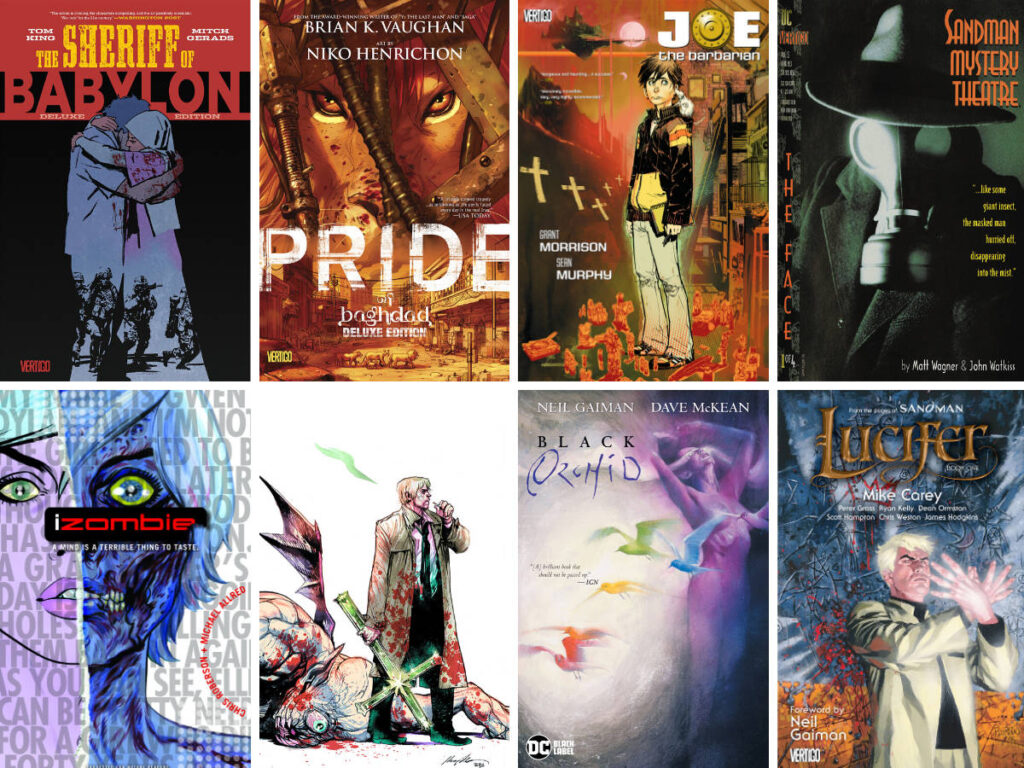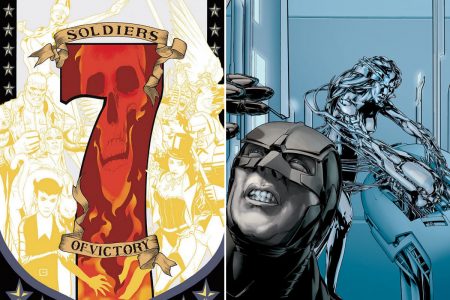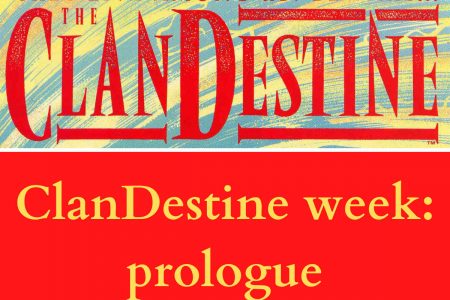It was sad but not completely surprising news that DC Comics would be shuttering its Vertigo imprint last year. With the official closing this year, the comic book industry lost an imprint that changed the way comic books were made and appreciated by the rest of the world and paved the way for the creator-owned explosion. I thought I’d belatedly add to the general noise of fans mourning the loss of a beloved corner of the comic book world.
Vertigo meant a lot to me because it happened around the time that my understanding and appreciation of the medium of comic books was expanding – I don’t know if this makes me biased towards it, because the imprint was starting at the same time as my brain was expanding, but I can’t separate the two. They are forever interlinked in my evolution and comic-book reading, and I will always be grateful for showing a fan of the superhero genre that there were other genres I could enjoy.
The birth of Vertigo started before the Vertigo launch in January 1993, and the books that led to it are generally considered to be part of Vertigo (trade paperback collections of the pre-Vertigo books would get the Vertigo trade dress), even though they technically weren’t. It started with Karen Berger, an editor at DC Comics since 1981. After taking over editing Alan Moore’s Swamp Thing in 1984, she began collecting British writers from 1986 onwards that would lead to Vertigo. The Hellblazer solo series, Black Orchid by Neil Gaiman and Dave McKean, Grant Morrison’s Animal Man and Doom Patrol, soon to be followed by Neil Gaiman’s The Sandman (perhaps the definitive Vertigo series) and Peter Milligan’s Shade, The Changing Man. Berger eventually had a meeting with the top people at DC comics (Paul Levitz, Jenette Kahn and Dick Giordano) and was given the mandate to put her ‘Suggested for Mature Readers’ books under an imprint. She would have a piece of good luck in that Art Young, a former DC editor who had worked with Berger, had been developing another imprint, Touchmark Comics, at Disney Comics that was unfortunately abandoned but meant Young had a slate of books ready to go that he brought to Vertigo, including one of my favourites, Engima by Milligan and Duncan Fegredo.
My transformative comic-book reading years were 1990 to 1994, so this covers the proto-Vertigo and Vertigo eras. I was a typical Marvel X-Men zombie up until then, having discovered The Uncanny X-Men at a formative age (see this post) and buying the various mutant titles (The New Mutants, X-Factor, Excalibur) before branching out to other interesting titles (Walt Simonson’s The Mighty Thor and Fantastic Four, Louise Simonson and June Brigman’s Power Pack, Ann Nocenti’s Daredevil, Peter David’s The Incredible Hulk). At university, I chanced upon reprints of Morrison’s Animal Man and Howard Chaykin’s reboot of The Shadow, which opened my eyes, which were then fully opened and my mind expanded when I went onto postgraduate studies at the end of 1991, helped by the ease of access to the various rec.arts.comics. groups online because we had to be online for the purposes of doing a scientific degree. People would rave about books such as The Sandman, Doom Patrol and Shade, The Changing Man, and I was lucky enough to have a comic book shop near campus that stocked all these books (and had a 10% discount on the new-fangled trade paperback collections that blew my mind – all those comic books in one handy-to-read volume!). I never looked back. The burgeoning indie scene was another helpful taste-widener (I would start picking up Usagi Yojimbo collections during this period), but Vertigo would cement the development of the medium of comic books as something far more diverse than my previous blinkered experience. (I should point out that I still love superhero comic books, but I had moved away from just buying the books that came out, instead following interesting creators as they played with the medium and characters.)
Vertigo was the stamp of quality and something different in a time when the superhero comic books were going through a crazy time full of violent heroes with big guns and big shoulder pads – Image Comics had launched in 1992 and the artist was king while story was secondary (with a few notable exceptions, obviously) and the big two were playing catch-up with more crossovers and hologram/embossed/metal covers, storylines where you had to follow multiple books to get the whole picture. With Vertigo, you knew that there was a taste maker behind the scenes selecting the books that were distinctive and interesting, meaning you were more likely to try something from an unknown creative team.

Another great aspect of Vertigo was the variety of genres on offer – although the phenomenal success of The Sandman led to a plethora of goth-infused fairy stories and the like, there was no limit on what qualified as a Vertigo book. Scene of the Crime by Ed Brubaker and Michael Lark was a pure crime book, as was 100 Bullets by Brian Azzarello and Eduardo Risso. The Losers by Andy Diggle and Jock was an action book with conspiracy/espionage trappings. Transmetropolitan by Warren Ellis and Darick Robertson (which started out at the Helix imprint at DC) was a political sci-fi satire. Flex Mentallo and We3, both by Grant Morrison and Frank Quitely, were Vertigo comic books – how could they be considered stablemates anywhere else apart from Vertigo? The Invisibles by Grant Morrison and various artists was – well, let’s just say it wasn’t like anything else.
Even in the later years, Vertigo was an imprint that couldn’t be pinned down. Kurt Busiek’s Astro City would end up at Vertigo after starting out at the Homage imprint of Image Comics. Scott Snyder’s new take on the vampire, American Vampire, was a Vertigo book. Scalped by Jason Aaron and RM Guera was The Wire on the Indian reservations. iZombie by Chris Roberson and Mike Allred was a pop-art mash-up of the various ‘monsters’ from the Universal films. The latter-day phenomenon of Fables by Bill Willingham and various artists was perhaps the closest to Vertigo’s stomping grounds, but even that was tenuous. And then you could have The Sherriff of Babylon by Tom King and Mitch Gerads, a murder investigation set in Iraq after the downfall of Saddam Hussein. The comic book industry needed something like Vertigo to give novel voices their opportunity, and not just before they would go on to define Batman (in the cases of Snyder and King).
Vertigo was doomed to close because of the impossibly good deals given to creators – they would own their creations and could do with them what they liked, something that’s anathema to the executives who run the conglomerates that own comic book companies, wanting to make as much money off their work as possible. When Vertigo was no longer allowed to give such good deals to creators, all the big names moved on to where they could keep control. Then Berger was pushed out in 2013, and the writing was on the wall; Shelly Bond, who had long worked at Vertigo, was moved to the top job, but she was fired in 2016 due to the restructuring at DC, and so it was more of a case of when not if Vertigo would become a memory.
But Vertigo blazed brightly and its legacy is tremendous – the creators who started there and changed the industry, the way that the likes of Image Comics now is a home for creators and titles that would have felt right at home at Vertigo, the respect and acclaim that Vertigo title generated, and made comic books better overall. So, excluding the pre-Vertigo titles of Animal Man and Doom Patrol by Morrison, which would be on the list, here’s my favourite 10 Vertigo titles (which was a tough choice, having to cut 100 Bullets, Shade, the Changing Man and The Invisibles to keep it to 10):
10. Scalped
I was a bit of an evangelist when I discovered Scalped in the local library, and became a fan of Jason Aaron because of it. Personally, I didn’t like the ending, but the rest of the series is a phenomenal book, with great art, mostly from RM Guera.
9. Fables
There is an argument to be made as to whether Fables should have continued past the completion of the Adversary that saga, which was the main thrust of the series. However, a book that created a modern story based around fairy-tale characters having to leave their otherworldly home and settle in New York was always going to have more stories to tell. Bill Willingham and Mark Buckingham made Fables a wonderful book, filled with great characters that played with their archetypes, and placed them in entertaining stories.

8. The Losers
This was my first exposure to the writing of Andy Diggle (a former editor at 2000 AD) and the stylish art of Jock, and it was an explosive first taste. Taking the name of an old DC story, Diggle and Jock fashioned a tale of a special ops team working with the CIA who were betrayed by their handler and left for dead, but who regrouped to get revenge and their lives back. Exciting, cool, dynamic, explosive, and with a few things to say about the War on Terror, The Losers was 32 issues of perfection.
7. We3
A charming, if that’s the right word, story about three animals that have been weaponised by the US military but then released by their creator when the project is going to be shut down. It’s only three issues by Grant Morrison and Frank Quitely, but they are three absolutely lovely issues that pluck the heartstrings.
6. Flex Mentallo
A spin-off from Morrison’s Doom Patrol, this saw him team up again with Quitely to tell a four-issue story about a superhero who can alter reality by flexing his muscles, while being a tale about reality, imagination, metafiction and the positivity of superheroes. The description doesn’t do it justice, unlike Quitely’s amazing art that matches Morrison’s imagination.
5. Enigma
One of the Vertigo launch books, Engima was written by Peter Milligan (best known for Shade, The Changing Man, which had been going for nearly three years before becoming another Vertigo book) and drawn by Duncan Fegredo. It was an eight-issue series about an ordinary man whose life is changed when the villains and hero (the Enigma) from his childhood comic books suddenly arrive in his world, and he has to seek out the character’s creator. The story and art are beautiful, as they take in concepts of the effect of art on life, identity, and the relationship between author and reader.
4. Y: The Last Man
It seems to be taking a long time for Y: The Last Man to make it to our screens (and probably longer with the COVID-19 pandemic), but we’ll always have the 60 issues by Brian K Vaughan and Pia Guerra. It tells the story of Yorick and his monkey Ampersand, seemingly the only male creatures left alive after an event that caused the simultaneous death of anything with a Y chromosome, trying to survive this new world and find his girlfriend and his family. Smart, sharp, funny and moving, it’s a terrific book worthy of its many awards.
3. Preacher
Garth Ennis and the late Steve Dillon had a great run on Hellblazer, but it was Preacher that exploded and shook comic books by their necks with gleeful love and malice. The story of a preacher, accidentally possessed by a supernatural entity called Genesis that is the product of an angel and a demon, who goes on a quest to find God with his ex-girlfriend and an Irish vampire, it is profane and beautiful, funny and angry, exciting and disgusting, and an absolute treat.
2. The Sandman
Neil Gaiman’s The Sandman is the essential Vertigo comic book, rightly placed at the top of most lists of best Vertigo books, and perhaps the book that built and supported Vertigo during its early years. Even though the first 46 issues were not Vertigo, The Sandman came to define what Vertigo was trying to attain: literary comic books for older readers who wanted their brains challenged while enjoying the special mix of words and pictures. I started reading the individual issues with the Season of Mists storyline, where I think The Sandman really hit its stride, and it’s funny to remember the agonising wait between issues towards the end of its run as it took Gaiman longer and longer to write each issue. The story of Dream of the Endless (and the nature of stories themselves), illustrated by various artists, beautifully written by Gaiman, it’s the book that everyone thinks of when they think of Vertigo, and is a genuine masterpiece of comic books.
1. Transmetropolitan
The recent revelations about Warren Ellis complicates the assessment of his work and the separating the artist from the work, and I feel conflicted; however, Transmetropolitan still remains my favourite Vertigo work. Along with Darick Robertson on art, the pair created a fantastic character in Spider Jerusalem, a journalist in the future who is brought back to chronicling the world in the City and all its flaws and beauty. It started at the Helix imprint, but survived the imprint’s cancellation to finish its 60-issue run and, to my mind, remains Ellis’s magnum opus (and not just because I got a letter printed in the series). A biting political satire that feels unfortunately prescient, it still has the power to move and make you think while it makes you smile.




